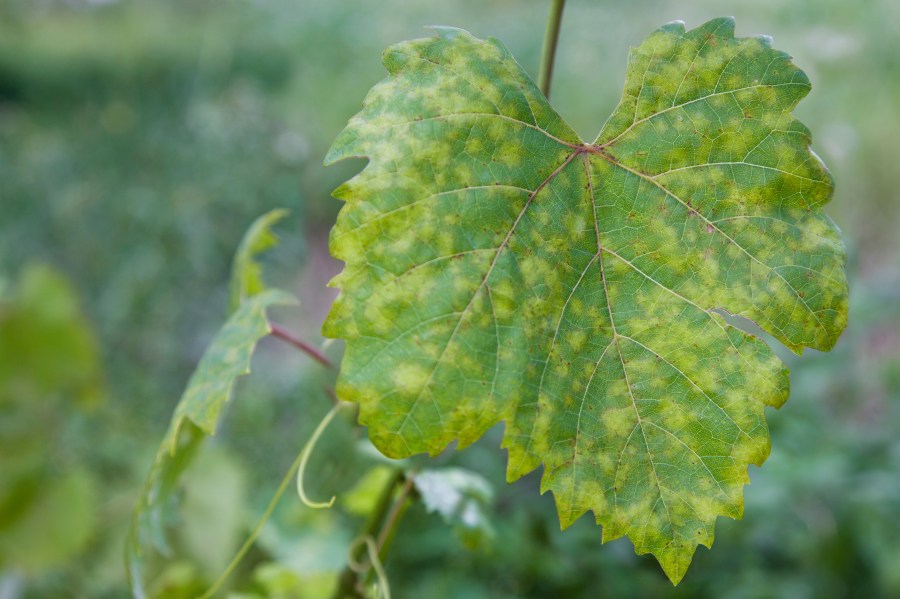After the high downy mildew pressure experienced in many vineyards last year, Hutchinsons agronomist Megan Fitzpatrick considers how to manage the potential carryover risks this season.
Spring 2025 has so far been something of a contrast to last year, as the driest March for 60 years continued into a dry start to April; conditions that, at the time of writing at least, do not favour downy mildew infection.
However, we know the risks from overwintered resting spores (oospores) could still be higher this spring given the significant infection pressure many areas faced in 2024, so growers must be prepared. Recent dry weather will not kill oospores in the soil and leaf litter or delay the onset of any infection. Even strong UV light will not kill resting spores until they have germinated.
This spore activation begins with incubation, when oospores are wetted for more than 16 hours when the temperature exceeds 8°C. Primary infection then occurs when resulting zoospores are splashed onto wet foliage and the “10-10-24” rule of thumb is met, i.e. at least 10mm of rain, temperatures of 10°C or more, for at least 24 hours, so, it is well worth monitoring local conditions to assess risk.
Recognise too, that this rule of thumb does not just apply to your site; spores can travel on the wind, so if anywhere in the county hits the 10-10-24 threshold, infection risk is there.
Protection is better than cure
Preventative spray programmes for downy mildew usually begin around late woolly bud stage, and typically involve copper oxychloride for downy mildew, plus sulphur for powdery mildew. This may have been preceded by an earlier sulphur application at early woolly bud for powdery mildew and vine leaf blister mite defence.
A repeat application of copper oxychloride at the 2-3 leaf stage is often a worthwhile follow-up, applied with alternative powdery mildew protection where required, and an early foliar feed.
It is worth noting that some sulphur products should not be applied in very strong sunlight or temperatures above 25°C, so always check the label. Maintaining agitation throughout application is also important as sulphur can be harder to mix and potentially cause blockages.
When further downy mildew treatments are required later into the summer, it is important to be flexible with spray timings, as we saw last year that some growers got caught out where a rigid two-week programme was followed, meaning that growth emerging soon after treatment was potentially left exposed for up to a fortnight.
Cultural options
Alongside well-timed preventative spray applications, there are several cultural measures that can help reduce downy mildew risk.
One is to minimise the potential for spores to splash from the soil up onto canes or lower leaves. Simple measures like removing suckers and keeping grass short can help increase this splash buffer zone, while it may also be worth considering steps to reduce the risk of puddles forming on bare earth beneath vines.
Ensuring good airflow around vineyards is key to mitigating many fungal diseases, so pay attention to managing windbreaks and other vegetation around the site, as well as the canopy itself throughout the season. This can also help reduce the wetness needed for spores to germinate and improve UV light penetration, something that can naturally kill downy mildew spores.
Detecting spores in the vineyard
This season, Hutchinsons is working with partners in the Innovate UK Farming Innovation Programme, to develop a novel system for detecting spores in vineyards and orchards to assess the correlation with established decision support systems, such as RIMpro.
The SporeSentry system, which is similar in size to a weather station, involves a cyclone air sampler that collects spores, the DNA from which is analysed through a PCR or LAMP test to identify the type and quantity of fungal DNA present.
The aim is to develop a fully automated system that can provide growers with real-time disease warnings and improve the decision making of farmers and agronomists using fungicides. Two devices will be trialled to detect scab in orchards this season, and another will be placed in a vineyard to detect downy mildew.
It is hoped that SporeSentry will become a vital part of the agricultural disease surveillance toolkit, providing evidence for supporting spraying when disease spores are present and reducing or removing the need for spraying when they are not.
For more like this, sign up for the FREE Vineyard newsletter here and receive all the latest viticulture news, reviews and insight




